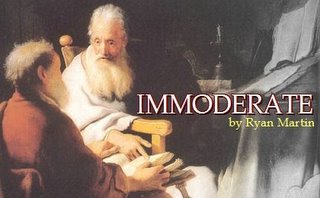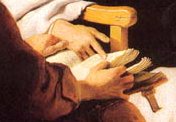Premoderns wonder
The common distinctions between the prevailing epochs of the thought-constructs of mankind are threefold: premodern, modern, and postmodern. Myron Penner summarizes:
“In premodernity rational thought begins with an attitude of wonder, and the basic orientation for philosophical reflection is characterized as an attempt to explain the perplexities of the universe (which cause one to wonder). . . . There is a sense of awe and mystery, and even gratitude, that accompanies premodern philosophical reflection” (Christianity and the Post Modern Turn [Grand Rapids: Brazos, 2005], 23). Incidently, Penner adds two other characteristics of premodern thought: no intrinsic antithesis between faith and reason, and the life of reason is a communal event. This radically changed from the Enlightenment. Penner explains, “The form of rational inquiry inherited from the premoderns becomes, in modernity, inherently suspect. . . . Thus doubt, not wonder, is the fundamentally rational posture, for doubt is the only means for a modern self to guarantee that he or she is not deceived” (24).
Richard Weaver is insightful on this principle of wonder. He says (in one of the most remarkable extra-Biblical paragraphs I have ever read),
“When we affirm that philosophy begins with wonder, we are affirming in effect that sentiment is anterior to reason. We do not undertake to reason about anything until we have been drawn to it by an affective interest. In the cultural life of man, therefore, the fact of paramount importance about anyone is his attitude toward the world. . . . We begin our other affirmations after a categorical statement that life and the world are to be cherished” (Ideas Have Consequences [Chicago: University of Chicago, 1948], 19).
There is the spirit of wonder shining through. This reminds me of another Weaver remark in his essay “Up from Liberalism”: “I found myself in decreasing sympathy with those social political doctrines erected upon the concept of a man-dominated universe and more and more inclined to believe with Walt Whitman that ‘a mouse is miracle enough to stagger sextillions of infidels.’”
And this reminds me of G. K. Chesterton, who wrote,
“The ordinary scientific man is strictly a sentimentalist. He is a sentimentalist in this essential sense, that he is soaked and swept away by mere associations. He has so often seen birds fly and lay eggs that he feels as if there must be some dreamy, tender connection between the two ideas, whereas there is none. A forlorn lover might be unable to dissociate the moon from lost love; so the materialist is unable to dissociate the moon from the tide. In both cases there is no connection, except that one has seen them together. A sentimentalist might shed tears at the smell of apple-blossom, because, by dark association of his own, it reminded him of his boyhood. So the materialist professor (though he conceals his tears) is yet a sentimentalist, because, by a dark association of his own, apple-blossoms remind him of apples. But the cool rationalist from fairyland does not see why, in the abstract, the apple tree should not grow crimson tulips; it sometimes does in his country” ("The Ethics of Elfland" in Orthodoxy).
Which in turn reminds me of a Latin hymn:
O magnum mysterium
et admirabile sacramentum,
ut animalia viderent
Dominum natum,
jacentem in præsepio.
O great mystery
And astonishing sacrament
That animals should see
The birth of the Lord
Lying in a manger.
“In premodernity rational thought begins with an attitude of wonder, and the basic orientation for philosophical reflection is characterized as an attempt to explain the perplexities of the universe (which cause one to wonder). . . . There is a sense of awe and mystery, and even gratitude, that accompanies premodern philosophical reflection” (Christianity and the Post Modern Turn [Grand Rapids: Brazos, 2005], 23). Incidently, Penner adds two other characteristics of premodern thought: no intrinsic antithesis between faith and reason, and the life of reason is a communal event. This radically changed from the Enlightenment. Penner explains, “The form of rational inquiry inherited from the premoderns becomes, in modernity, inherently suspect. . . . Thus doubt, not wonder, is the fundamentally rational posture, for doubt is the only means for a modern self to guarantee that he or she is not deceived” (24).
Richard Weaver is insightful on this principle of wonder. He says (in one of the most remarkable extra-Biblical paragraphs I have ever read),
“When we affirm that philosophy begins with wonder, we are affirming in effect that sentiment is anterior to reason. We do not undertake to reason about anything until we have been drawn to it by an affective interest. In the cultural life of man, therefore, the fact of paramount importance about anyone is his attitude toward the world. . . . We begin our other affirmations after a categorical statement that life and the world are to be cherished” (Ideas Have Consequences [Chicago: University of Chicago, 1948], 19).
There is the spirit of wonder shining through. This reminds me of another Weaver remark in his essay “Up from Liberalism”: “I found myself in decreasing sympathy with those social political doctrines erected upon the concept of a man-dominated universe and more and more inclined to believe with Walt Whitman that ‘a mouse is miracle enough to stagger sextillions of infidels.’”
And this reminds me of G. K. Chesterton, who wrote,
“The ordinary scientific man is strictly a sentimentalist. He is a sentimentalist in this essential sense, that he is soaked and swept away by mere associations. He has so often seen birds fly and lay eggs that he feels as if there must be some dreamy, tender connection between the two ideas, whereas there is none. A forlorn lover might be unable to dissociate the moon from lost love; so the materialist is unable to dissociate the moon from the tide. In both cases there is no connection, except that one has seen them together. A sentimentalist might shed tears at the smell of apple-blossom, because, by dark association of his own, it reminded him of his boyhood. So the materialist professor (though he conceals his tears) is yet a sentimentalist, because, by a dark association of his own, apple-blossoms remind him of apples. But the cool rationalist from fairyland does not see why, in the abstract, the apple tree should not grow crimson tulips; it sometimes does in his country” ("The Ethics of Elfland" in Orthodoxy).
Which in turn reminds me of a Latin hymn:
O magnum mysterium
et admirabile sacramentum,
ut animalia viderent
Dominum natum,
jacentem in præsepio.
O great mystery
And astonishing sacrament
That animals should see
The birth of the Lord
Lying in a manger.







3 Comments:
I just heard a magnificent Lauredsen setting of this hymn this evening performed by the BJU Chorale at a concert at our church.
Sounds like what CS Lewis wanted to get back. Gaius and Titius, in The Green Book, stole this wonderment from the youths before they were able to use reason to investigate. They were men without chests. "It is not that their heads are so very large - they just look big because of the atrophy of their chests" (paraphrase)
Scott, if this is what I have in common with the BJU chorale, I am glad for it.
Jesse, I agree that Lewis was after this as well.
Post a Comment
<< Home